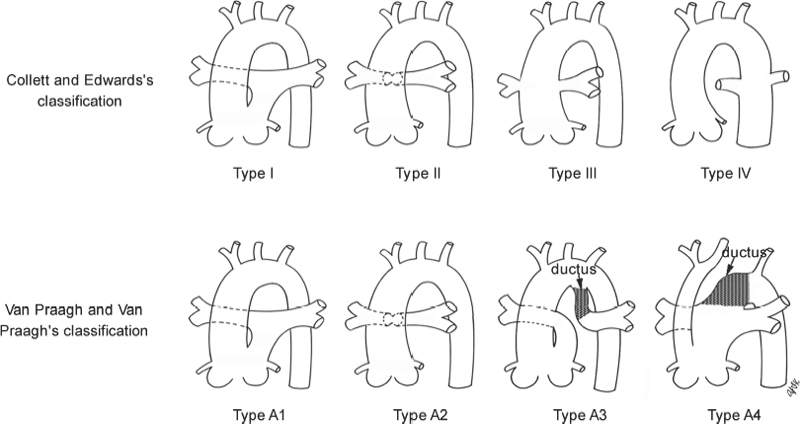13 Truncus Arteriosus Fig. 13.1 Collett and Edwards’s (top panel) and Van Praagh and Van Praagh’s (bottom panel) classification systems.
Definition and Classification
 Characterized by a single great artery arising from the base of the heart, which gives origin to systemic, pulmonary, and coronary arteries
Characterized by a single great artery arising from the base of the heart, which gives origin to systemic, pulmonary, and coronary arteries
 Presence of only one arterial trunk is necessary for the diagnosis without any remnant of an atretic pulmonary artery or aorta.
Presence of only one arterial trunk is necessary for the diagnosis without any remnant of an atretic pulmonary artery or aorta.
 Almost always centered over a large ventricular septal defect
Almost always centered over a large ventricular septal defect
 Commonly used synonyms: persistent truncus arteriosus and common arterial trunk
Commonly used synonyms: persistent truncus arteriosus and common arterial trunk
 Collett and Edwards’s classification relates to the site of origin of the pulmonary arteries from the common arterial trunk (Fig. 13.1, upper panel)
Collett and Edwards’s classification relates to the site of origin of the pulmonary arteries from the common arterial trunk (Fig. 13.1, upper panel)
 Van Praagh and Van Praagh’s modification (Fig. 13.1, lower panel)
Van Praagh and Van Praagh’s modification (Fig. 13.1, lower panel)

Pathophysiology
 Intracardiac admixture lesion at ventricular septal defect level due to similar pressures in both ventricles
Intracardiac admixture lesion at ventricular septal defect level due to similar pressures in both ventricles
 Extracardiac left-to-right shunt at truncal level with a significant increase in pulmonary flow when pulmonary vascular resistance decreases
Extracardiac left-to-right shunt at truncal level with a significant increase in pulmonary flow when pulmonary vascular resistance decreases
 Occasionally the pulmonary blood flow may be restrictive when there is associated obstruction
Occasionally the pulmonary blood flow may be restrictive when there is associated obstruction
Stay updated, free articles. Join our Telegram channel

Full access? Get Clinical Tree






